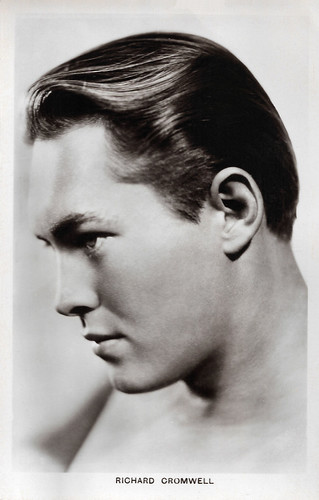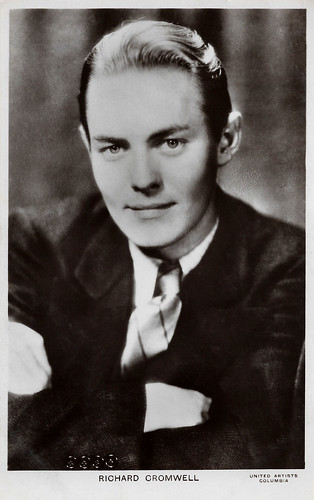
British postcard in the Picturegoer Series, London, no. 955. Photo: Paramount. Richard Cromwell in The Lives of a Bengal Lancer (Henry Hathaway, 1935).

British postcard in the Picturegoer Series, London, no. 656.
Terrific debut performance in a very difficult role
Richard Cromwell was born LeRoy Melvin Radabaugh in Long Beach, California, in 1910. He was the second of five children of Fay B. (née Stocking) and Ralph R. Radabaugh, who was an inventor. In 1918, when Radabaugh was still in grade school, his father died of the Spanish flu. Roy earnestly delivered morning newspapers to help out with the family's budget crisis.
On a scholarship, he attended the Chouinard Art Institute in Los Angeles, a precursor to the California Institute of the Arts. He continued to work part-time as a maintenance man, custodian and soda jerk. He set up a small art shop in Hollywood in the late 1920s and made masks and oil paintings there. He sold pictures, made lampshades, and designed colour schemes for houses. The handsome Cromwell made contacts with film stars of the time such as Anna Q. Nilsson, Colleen Moore, Beatrice Lillie, Greta Garbo, Joan Crawford and Tallulah Bankhead, some of whom he also immortalised in his paintings and masks.
He painted scenery for community theatre productions and eventually took on acting roles. His first film appearance was an extra role in King of Jazz (John Murray Anderson, Walter Lantz, 1930), along with the film's star, Paul Whiteman and his orchestra. On a whim, his friends encouraged him to audition for the lead role in a Columbia remake of D.W. Griffith's silent classic Tol'able David (1921) starring Richard Barthelmess. Radabaugh won the role over thousands of hopefuls. In storybook fashion, studio mogul Harry Cohn gave him his screen name Richard Cromwell and launched his career.
Cromwell earned $75 per week for his work on Tol'able David (John G. Blystone, 1930), which co-starred Noah Beery Sr. and John Carradine. Gary Brumburgh at IMDb: "The studio publicity machines worked overtime to promote both the film and their new leading man. Richard lived up to all the hype once the reviews came out, giving a terrific debut performance in a very difficult role. As the rather weak-willed young boy who finds the strength and courage to right the injustice done to him, he hit overnight stardom".
Amid the flurry of publicity, Cromwell toured the country and was even invited to the White House to meet President Herbert Hoover. Cohn signed Cromwell to a multi-year contract based on the strength of his performance and the success at the box office of his debut. In the following years, Richard played several leading roles in smaller films, often in youthful, somewhat sensitive roles. Leslie Halliwell later described him in his Filmgoer's Companion as the "friendly hero of the early talkies".
Cromwell maintained a deep friendship with Marie Dressler, which continued until her death from cancer in 1934. Dressler personally insisted that her studio bosses cast Cromwell on a loan-out in the lead opposite her in Emma (Clarence Brown, 1932), also with Myrna Loy. Dressler was nominated for a second Best Actress award for her portrayal of the title role in Emma. This was another break that helped sustain Cromwell's rising status in Hollywood. He was now much in demand and his next roles were in The Age of Consent (Gregory La Cava, 1932) co-starring Arline Judge and Eric Linden, Tom Brown of Culver (William Wyler, 1932), and Hoopla (Frank Lloyd, 1933), where he is seduced by Clara Bow, in her final film.
He made an early standout performance as the leader of the youth gang in Cecil B. DeMille's unusual cult-favourite, This Day and Age (1933). To ensure that Cromwell's character used the right slang, DeMille asked high school student Horace Hahn to read the script and comment. Cromwell then starred with Jean Arthur in Most Precious Thing in Life (Lambert Hillyer, 1934). He had his definitive breakthrough when he co-starred with Gary Cooper and Franchot Tone in the adventure film The Lives of a Bengal Lancer (Henry Hathaway, 1935), which was nominated for seven Oscars. Cromwell played the son of a senior officer who was tortured by insurgents. His father refuses to rescue him to demonstrate his impartiality. After this promising start, Cromwell's career received a bump when he wanted more artistic independence.

British postcard in the Picturegoer Series, London, no. 656a. Photo: United Artists, Columbia.
Running the gamut of emotions
Richard Cromwell's next pictures at Columbia Pictures and elsewhere were mostly inconsequential. Cromwell starred with Will Rogers in Life Begins at 40 (George Marshall, 1935) and appeared in Poppy (A. Edward Sutherland, 1936) as the suitor of W.C. Fields' daughter, Rochelle Hudson. In 1937, he portrayed the young bank robber in love with Helen Mack and on the lam from Lionel Atwill in The Wrong Road.
A challenge was his lead role in The Road Back (James Whale, 1937), a sequel to the classic All Quiet on the Western Front (Lewis Milestone, 1930). The film chronicled the story of young German soldiers readjusting to civilian life after WWI. Fearful that this film would not do well in Germany, the new regime at Universal Pictures severely edited the film before release, removing much of the strongly anti-Nazi slant that author Erich Maria Remarque included in the original novel, and which director James Whale had intended to retain in the film version. The resulting film was not well-received.
Richard Cromwell took a detour in his career to Broadway for the chance to star as an evil cadet in an original play by Joseph Viertel, 'So Proudly We Hail!'. The military drama was directed by future film director Charles Walters, co-starred Edward Andrews and Eddie Bracken, and opened to much fanfare. The New York Herald Tribune called Cromwell's acting "a striking portrayal" and The New York Times said that he "ran the gamut of emotions" in the play. Cromwell had shed his restrictive Columbia contract and pursued acting work as a freelancer in other media.
Cromwell guest-starred on the radio in 'The Royal Gelatin Hour' (1937) hosted by Rudy Vallee, in a dramatic skit opposite Fay Wray. Enjoying the experience, Cromwell acted in the role of Kit Marshall on the radio soap opera 'Those We Love', which ran from 1938 until 1942. On-screen, Cromwell appeared in Storm Over Bengal (Sidney Salkow, 1938), for Republic Pictures, in order to capitalise on his success in The Lives of a Bengal Lancer. He stood out in supporting roles as Henry Fonda's brother, who kills a man in a duel of honour, in the romantic drama Jezebel (William Wyler, 1938) starring Bette Davis and as defendant Matt Clay to Henry Fonda's title performance in Young Mr. Lincoln (John Ford, 1939).
In 1939, Cromwell again tried his luck on stage in a regional production of Sutton Vane's play 'Outward Bound', co-starring Dorothy Jordan. Cromwell drifted into secondary features. He enjoyed an active social Hollywood life with friends including Barbara Stanwyck, Joan Crawford, Franchot Tone, George Cukor, Cole Porter and William Haines. For Universal Pictures, Cromwell starred as a draftsman who thwarts the Nazis in Enemy Agent (Lew Landers, 1940). He went on to appear in marginal but still watchable fare such as Baby Face Morgan (Arthur Dreifuss, 1942), with Mary Carlisle. Cromwell enjoyed a career boost with Cosmo Jones, Crime Smasher (James Tinling, 1943), the film adaptation of the hit radio serial. However, he was next up at Monogram Pictures, where he was cast as a doctor working covertly for a police department to catch mobsters in the forgettable though endearing Riot Squad (Edward Finney, 1941).

British postcard in the Picturegoer Series, London, no. 955a. Photo: Herbert Wilcox. Richard Cromwell in Our Fighting Navy (Norman Walker, 1937).
Charming with a good knowledge of jazz music
During the last two years of World War II, Richard Cromwell served with the United States Coast Guard. Upon returning to California following the war's end, he acted in local theatre productions. He also signed on for live performances in summer stock in the East during this period. Cromwell's break from films due to his stint in the Service meant that he was not much in demand after the War's end. He failed to make a comeback as a film actor with a role in the Film Noir Bungalow 13 (Edward L. Cahn, 1948) and he retired from the film industry.
All told, Cromwell's film career spanned 39 films. In the 1950s, he returned to his artistic roots and studied ceramics. He built a pottery studio on his property, becoming especially known and admired for his creative tile designs. Returning to the name Roy Radabaugh, Cromwell also wrote extensively, producing several published stories and an unfinished novel in the 1950s.
Cromwell was married once, briefly (1945–1946), to actress Angela Lansbury, when she was 19 and Cromwell was 35. They were married in a small civil ceremony in Independence, California. Lansbury later stated in a 1966 interview that her first marriage was a mistake because Cromwell was gay. His homosexuality had been kept secret from the public and Lansbury had not known about it before the marriage. However, Cromwell and Lansbury remained friends until he died in 1960.
She later described him as "charming with a good knowledge of jazz music". In 1960 he tried a second comeback in the film business. In July 1960, Cromwell signed with producer Maury Dexter for 20th Century Fox's planned production of The Little Shepherd of Kingdom Come (Andrew V. McLaglen, 1961), starring singer Jimmie Rogers. Diagnosed with liver cancer shortly thereafter, he was forced to withdraw and Chill Wills replaced Cromwell in the film. Richard Cromwell was a heavy smoker for many years and at times advertised Lucky Strike.
He died on 11 October 1960 in Hollywood, at the age of 50. He is interred at Fairhaven Memorial Park in Santa Ana, California. For his services to the film industry, Cromwell has a star on the Hollywood Walk of Fame (1627 Vine Street). Cromwell's legacy is preserved today by his nephew Dan Putnam and his cousin Bill Keane IV. In 2005, Keane donated materials relating to Cromwell's radio performances to the Thousand Oaks Library's Special Collection, "The American Radio Archive". In 2007, Keane donated memorabilia relating to Cromwell's film career and ceramics work to the AMPAS Margaret Herrick Library in Beverly Hills.

British postcard by Film Weekly, London.

Vintage card. Richard Cromwell and Kathleen Burke in The Lives of a Bengal Lancer (Henry Hathaway, 1935).
Sources: Gary Brumburgh (IMDb), Leslie Halliwell (Filmgoer's Companion), Wikipedia (English and German) and IMDb.
This post was last updated on 10 November 2023.
No comments:
Post a Comment